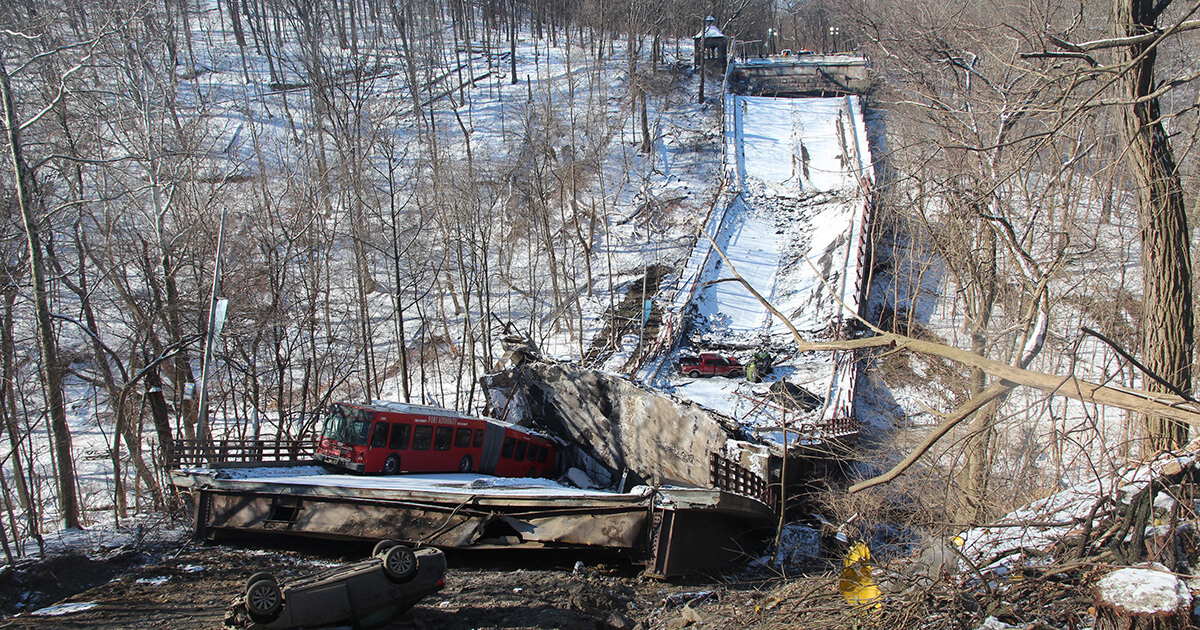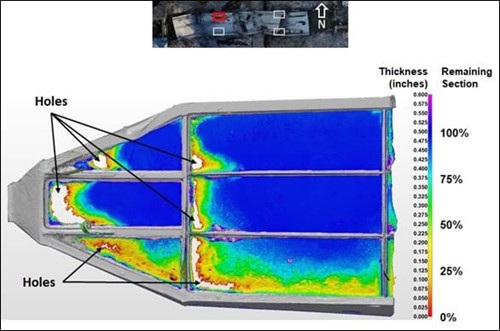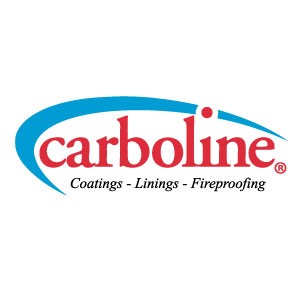
In May 2023, the U.S. National Transportation Safety Board (NTSB) did something it almost never does.
It published an urgent notice to state and federal agencies with findings from an investigation it had yet to complete.
Citing the January 2022 collapse of the Fern Hollow Bridge in Pittsburgh, Pennsylvania, the notice urged authorities nationwide to “review inspection reports and identify incomplete follow-up actions that need to be resolved for bridges made of uncoated weathering steel.”
“NTSB investigators found corrosion, deterioration, and section loss on all four of the bridge’s legs due to the continual accumulation of water and debris,” the Board wrote.
The bridge legs were made of corten steel, also known as weathering steel, which typically is not coated. The oxide layer that forms on its surface naturally in reaction to atmospheric exposure protects it rather well, very much like the green patina that forms on copper.
Corten steel has a long and generally successful service record for bridges and other infrastructure around the world. So what happened in Pittsburgh? Why was this different?
The collapse and investigation
The Fern Hollow Bridge carried Forbes Road over a ravine at the north end of a local park. A light snow was still falling when it collapsed about an hour before dawn on January 28, 2022.
Four cars and a city bus were on the bridge when it fell 100 feet (30 meters) down into the ravine. A fifth car drove off an abutment after the collapse. It couldn’t stop in time. Four people were hurt in the collapse, two of them seriously.
It didn’t take long for investigators to develop a theory of the cause. According to a supplemental report accompanying their urgent notice, the NTSB “found extensive corrosion damage and deterioration” of the bridge legs.
Worse, that damage was not new. “Starting in 2005, each of these (National Bridge Inspection Standards) inspection reports documented corrosion damage and deterioration of the bridge legs, including the most recent inspection report” which was filed four months before the collapse.
Laser scans of the corroded portions of the bridge legs supported empirically what was plainly visible to anyone who had looked: The bridge legs had suffered an alarming loss of thickness. In some areas, where there had once been a web of steel, only fist-sized holes remained.

The NTSB noted that environmental conditions influence corten performance. Most simply stated, it must be exposed to moisture but also be allowed to dry for the most complete development of a protective oxide layer. The addition of other airborne contaminants also contributes to speedier patina formation. (These reasons are why corten steel can last well over 100 years in more arid climates, and why patina forms more quickly on corten steel erected in cities where pollution is more concentrated.)
With all this in mind, investigators have developed a clear explanation of why this happened:
As engineered and built, the bridge legs wouldn’t have been in contact with layers of moist debris. But over time, drains on the road deck became clogged. Instead of being harmlessly channeled away as intended, rainwater, snowmelt, and some debris leaked over the edge of the bridge where it collected against the bridge legs.
Incidentally, the contaminants not helpful for patina formation on weathering steel include chlorides. Instead of contributing to a corrosion cycle that eventually ends, chlorides accelerate corrosion until there’s nothing left to corrode. We observe that it snows in Pittsburgh and assume that road salt had been applied to the bridge over its lifespan.
And it bears repeating that, time and time again, bridge inspectors reported these conditions and urged action that was not taken for 18 years.
Coat the corten steel, right?
Maybe. It’s complicated.
And it’s complicated because corten steel features a much more difficult surface to prepare compared to general-purpose carbon steel. The porous rust layer that forms on carbon steel clings to the substrate rather loosely. When a corrosion cycle is completed and the rust sloughs off (or when the steel is abrasive blasted), a new cycle begins. It’s an endless loop.
But the rust layer that forms over weathering steel is much denser and clings far more tightly to the substrate by design. This can be blasted away, but abrasive blasting a Fern Hollow Bridge’s worth of weathering steel would require a much higher volume of abrasive material than is ordinary and many more labor hours than most contractors are comfortable paying for.
In our view, a partial coat would be effective. Preparing and coating only the sections of an asset at highest risk of corrosive exposure can defend against section loss, especially if an asset’s recommended maintenance is going to be neglected. We hate saying it that way, but it happens too often not to be said plainly.
Our other view is that while uncoated weathering steel is a proven material for all manner of industrial and infrastructure assets, it is not universally ideal. Pittsburgh’s snowy winters, road salt, rain, and humid weather made corten a risky choice from the start, and the neglected maintenance that led to an unintended but widespread corrosion attack practically sealed the Fern Hollow Bridge’s fate as far back as 2005.
It was only a matter of time.
Coating recommendations for corten
If you’re responsible for the care of weathering steel in conditions you believe are risky, we suggest blocking moisture and corrosion-accelerating chemicals with the following generic coating systems:
Zinc-rich primers are a very sound choice. But these products require comparatively more intensive surface preparation because all rust and mill scale must be removed for best adhesion. It is very difficult to achieve a “near white” surface finish on corten steel. For that reason, applying a barrier epoxy is a viable and common alternative.
Whether a zinc-rich primer or barrier epoxy is specified, we also recommend a low-gloss, UV-stable urethane or polysiloxane topcoat. In addition to enhancing protection, this will help blend in the painted area with what is left unpainted. It probably won’t be perfect, but it is preferable to no attempt at blending at all if aesthetics is a concern.
As for which specific products are best, that will depend on climate- and weather-driven atmospheric exposures and service environment characteristics. Lean on Carboline’s Technical Service Engineers as your best resource here.
But before you do anything, thoroughly inspect corten steel assets. And if those inspection reports urge action, then act.

